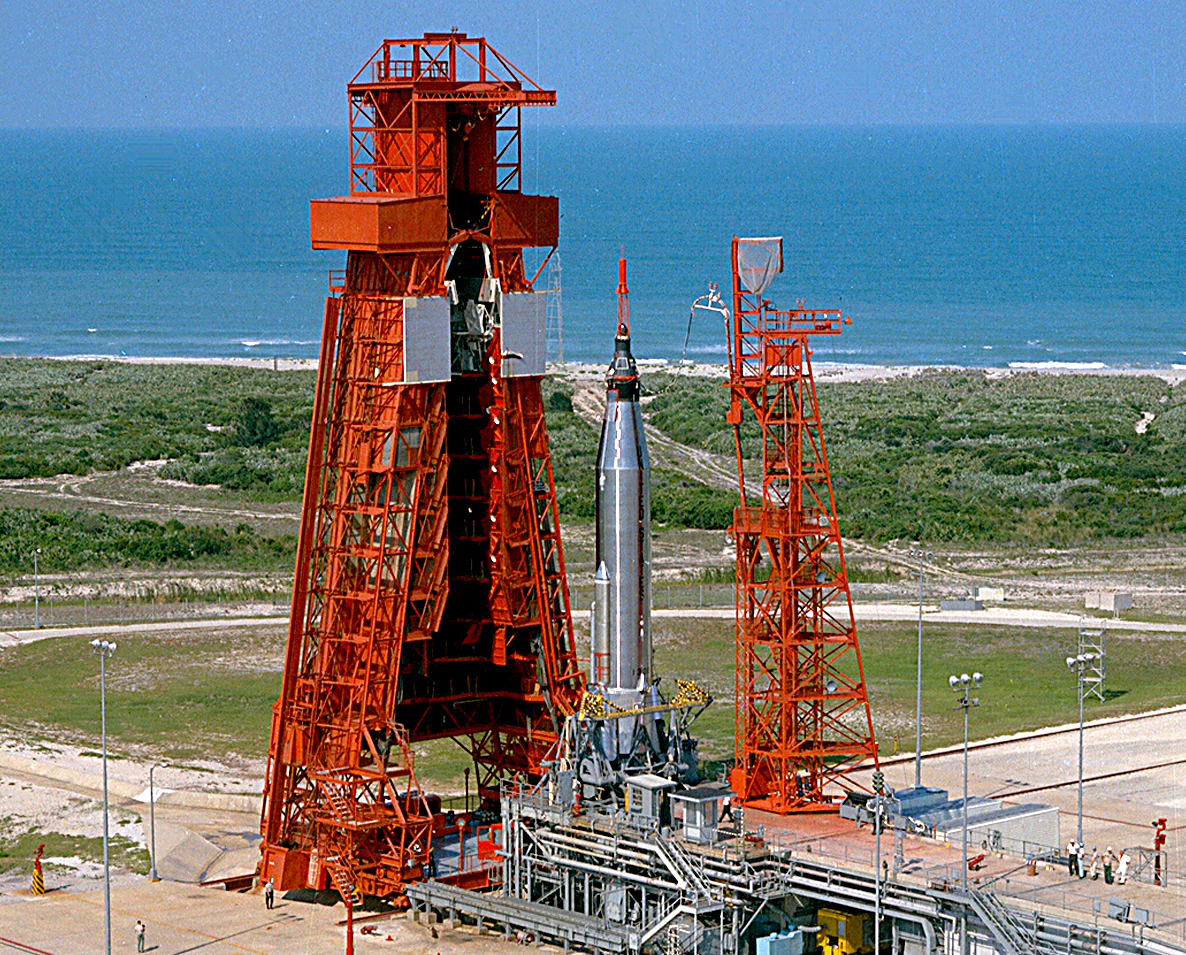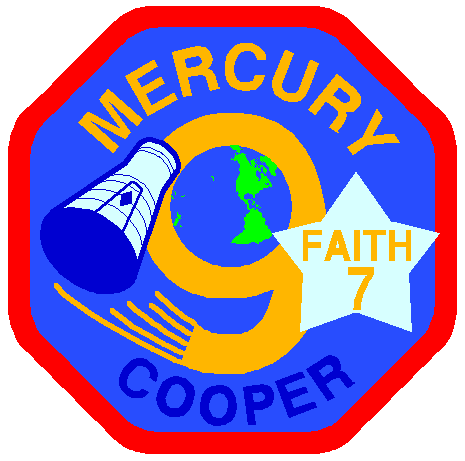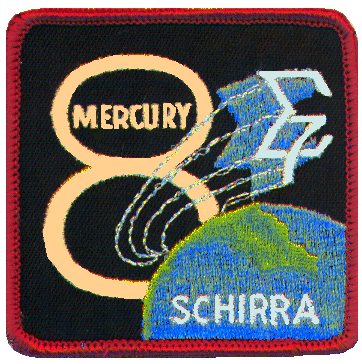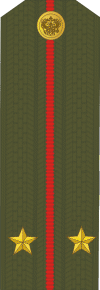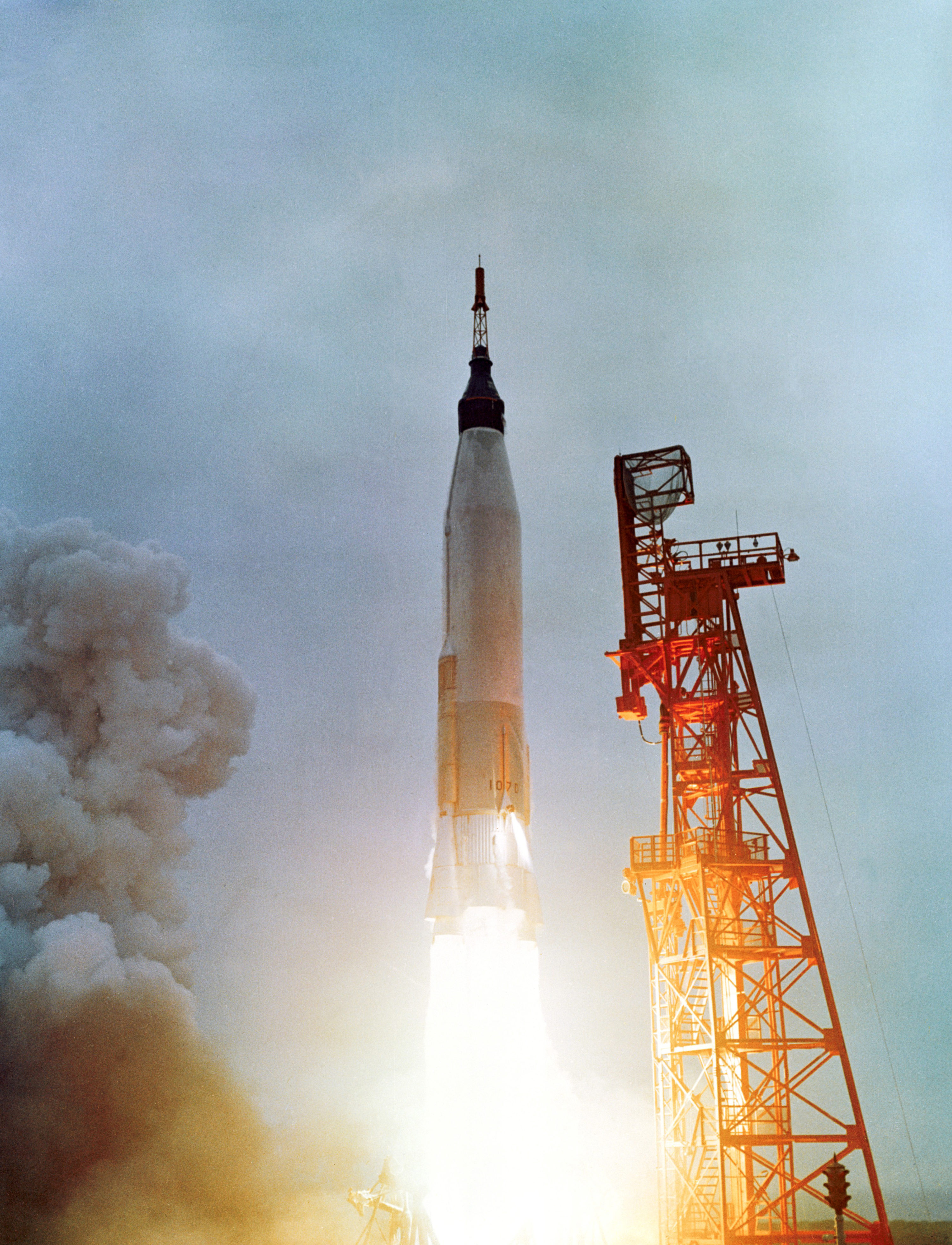|
List Of Human Spaceflights, 1961–1970
This is a detailed list of human spaceflights from 1961 to 1970, spanning the Soviet Vostok programme, Vostok and Voskhod programme, Voskhod programs, the start of the Soviet Soyuz program, the American Mercury program, Mercury and Gemini program, Gemini programs, and the first lunar landings of the American Apollo program. * indicates fatalities. * indicates sub-orbital spaceflight (including flights that failed to attain intended orbit). *Grey indicates flights to the Moon. *The United States defines spaceflight as any flight reaching an altitude of 50 miles, while the Fédération Aéronautique Internationale, FAI definition requires an altitude of 100 kilometers. During the 1960s, 13 crewed flights of the U.S. North American X-15 rocket plane met the U.S. criteria, of which only two met the FAI's. This article's primary list includes only the latter two flights. A separate, secondary list gives the other eleven which flew between 50 miles and 100 kilometers. Flights between ... [...More Info...] [...Related Items...] OR: [Wikipedia] [Google] [Baidu] |
Vostok Programme
The Vostok programme (russian: Восток, , ''Orient'' or ''East'') was a Soviet human spaceflight project to put the first Soviet citizens into low Earth orbit and return them safely. Competing with the United States Project Mercury, it succeeded in placing the first human into space, Yuri Gagarin, in a single orbit in Vostok 1 on April 12, 1961. The Vostok capsule was developed from the Zenit spy satellite project, and its launch vehicle was adapted from the existing R-7 Semyorka intercontinental ballistic missile (ICBM) design. The name "Vostok" was treated as classified information until Gagarin's flight was first publicly disclosed to the world press. The programme carried out six crewed spaceflights between 1961 and 1963. The longest flight lasted nearly five days, and the last four were launched in pairs, one day apart. This exceeded Project Mercury's demonstrated capabilities of a longest flight of just over 34 hours, and of single missions. Vostok was succeeded by ... [...More Info...] [...Related Items...] OR: [Wikipedia] [Google] [Baidu] |
Vostok 2
Vostok 2 (russian: Восток-2, ''Orient 2'' or ''East 2'') was a Soviet space mission which carried cosmonaut Gherman Titov into orbit for a full day on August 6, 1961, to study the effects of a more prolonged period of weightlessness on the human body. Titov orbited the Earth over 17 times, exceeding the single orbit of Yuri Gagarin on Vostok 1 − as well as the suborbital spaceflights of American astronauts Alan Shepard and Gus Grissom aboard their respective Mercury-Redstone 3 and 4 missions. Titov's number of orbits and flight time would not be surpassed by an American astronaut until Gordon Cooper's Mercury-Atlas 9 spaceflight in May 1963. After the flight of Vostok 1, Sergei Korolev took a short vacation in Crimea where he began working out the flight plan for the next mission. There were considerable arguments over the duration of the mission as flight doctors argued for no more than three orbits. The flight of Korabl-Sputnik 2 nine months earlier had carried two d ... [...More Info...] [...Related Items...] OR: [Wikipedia] [Google] [Baidu] |
Valery Bykovsky
Valery Fyodorovich Bykovsky (russian: Вале́рий Фёдорович Быко́вский; 2 August 1934 – 27 March 2019) was a Soviet cosmonaut who flew on three space flights: Vostok 5, Soyuz 22, and Soyuz 31. He was also backup for Vostok 3 and Soyuz 37. Early life and career Born in Pavlovsky Posad, Russia, on 2 August 1934, Bykovsky was the son of Fyodor Fyodorovich Bykovsky and Klavdia Ivanova. He had an older sister named Margarita born three years earlier. When he was four years old, World War II began, forcing the family to move to Kuybyshev, and later again to Syzran, before moving back to near Moscow. By the age of 14, Bykovsky wanted to attend naval school; however, his father was not a proponent of this idea and encouraged him to stay at his school. A few days later Bykovsky attended a lecture on the Soviet Air Force Club which inspired him to pursue his dream of becoming a pilot. He began flight theory lessons when he was 16 at the Moscow City Aviation Cl ... [...More Info...] [...Related Items...] OR: [Wikipedia] [Google] [Baidu] |
Mercury-Atlas 9
Mercury-Atlas 9 was the final crewed space mission of the U.S. Mercury program, launched on May 15, 1963, from Launch Complex 14 at Cape Canaveral, Florida. The spacecraft, named ''Faith 7'', completed 22 Earth orbits before splashing down in the Pacific Ocean, piloted by astronaut Gordon Cooper, then a United States Air Force major. The Atlas rocket was No. 130-D, and the Mercury spacecraft was No. 20. As of 2022, this mission marks the last time an American was launched alone to conduct an entirely solo orbital mission. Flight directors * Chris KraftRed team * John HodgeBlue team Mission parameters *Mass: *Perigee: 161 km *Apogee: 267 km *Inclination: 32.5° *Period: 88.5 min Mission background Debate over Mercury project continuation The Mercury-Atlas 8 flight of Walter Schirra on October 3, 1962, had been so nearly perfect that some at NASA thought that the United States should quit while it was ahead and make MA-8 the last Mercury mission rather than risk ... [...More Info...] [...Related Items...] OR: [Wikipedia] [Google] [Baidu] |
Gordon Cooper
Leroy Gordon "Gordo" Cooper Jr. (March 6, 1927 – October 4, 2004) was an American aerospace engineer, test pilot, United States Air Force pilot, and the youngest of the seven original astronauts in Project Mercury, the first human space program of the United States. Cooper learned to fly as a child, and after service in the United States Marine Corps during World War II, he was commissioned into the United States Air Force in 1949. After service as a fighter pilot, he qualified as a test pilot in 1956, and was selected as an astronaut in 1959. In 1963 Cooper piloted the longest and last Mercury spaceflight, Mercury-Atlas 9. During that 34-hour mission he became the first American to spend an entire day in space, the first to sleep in space, and the last American launched on an entirely solo orbital mission. Despite a series of severe equipment failures, he managed to successfully complete the mission under manual control, guiding his spacecraft, which he named ''F ... [...More Info...] [...Related Items...] OR: [Wikipedia] [Google] [Baidu] |
Mercury-Atlas 8
Mercury-Atlas 8 (MA-8) was the fifth United States crewed space mission, part of NASA's Mercury program. Astronaut Walter M. Schirra Jr., orbited the Earth six times in the ''Sigma 7'' spacecraft on October 3, 1962, in a nine-hour flight focused mainly on technical evaluation rather than on scientific experimentation. This was the longest U.S. crewed orbital flight yet achieved in the Space Race, though well behind the several-day record set by the Soviet Vostok 3 earlier in the year. It confirmed the Mercury spacecraft's durability ahead of the one-day Mercury-Atlas 9 mission that followed in 1963. Planning began for the third U.S. orbital mission in February 1962, aiming for a six-or-seven-orbit flight to build on the previous three-orbit missions. NASA officially announced the mission on June 27, and the flight plan was finalized in late July. The mission focused on engineering tests rather than on scientific experimentation. The mission finally launched on the morning of Octo ... [...More Info...] [...Related Items...] OR: [Wikipedia] [Google] [Baidu] |
Wally Schirra
Walter Marty Schirra Jr. (, March 12, 1923 – May 3, 2007) was an American naval aviator, test pilot, and NASA astronaut. In 1959, he became one of the original seven astronauts chosen for Project Mercury, which was the United States' first effort to put human beings into space. On October 3, 1962, he flew the six-orbit, nine-hour, Mercury-Atlas 8 mission, in a spacecraft he nicknamed ''Sigma 7''. At the time of his mission in ''Sigma 7'', Schirra became the fifth American and ninth human to travel into space. In the two-man Gemini program, he achieved the first space rendezvous, station-keeping his Gemini 6A spacecraft within of the sister Gemini 7 spacecraft in December 1965. In October 1968, he commanded Apollo 7, an 11-day low Earth orbit shakedown test of the three-man Apollo Command/Service Module and the first crewed launch for the Apollo program. Before becoming an astronaut, Schirra graduated with a Bachelor of Science degree from the United States Naval Ac ... [...More Info...] [...Related Items...] OR: [Wikipedia] [Google] [Baidu] |
Vostok 4
Vostok 3 (russian: Восток-3, lit=Orient 3' or 'East 3) and Vostok 4 (, 'Orient 4' or 'East 4') were Soviet space program flights in August 1962, intended to determine the ability of the human body to function in conditions of weightlessness, test the ground control capability to launch and manage two separate, concurrent flights, and test the endurance of the Vostok 3KA spacecraft over longer flights. Cosmonaut Andriyan Nikolayev orbited the Earth 64 times in Vostok 3 over nearly four days in space, August 11–15, 1962, a feat which would not be matched by NASA until the Gemini program (1965–1966). Pavel Popovich was launched on Vostok 4 on August 12, and made 48 Earth orbits. The two capsules were launched on trajectories that brought the spacecraft within approximately of each another. They also communicated with each other via radio, the first ship-to-ship communications in space. These missions marked the first time that more than one crewed spacecraft was in orbi ... [...More Info...] [...Related Items...] OR: [Wikipedia] [Google] [Baidu] |
Pavel Popovich
Pavel Romanovich Popovich (russian: Па́вел Рома́нович Попо́вич, uk, Павло Романович Попович, Pavlo Romanovych Popovych) (5 October 1930 – 29 September 2009) was a Soviet cosmonaut. Popovich was the fourth cosmonaut in space, the sixth person in orbit, the eighth person and first Ukrainian in space. Biography Popovich was born in Uzyn, Kyiv Oblast, Ukrainian SSR to Roman Porfirievich Popovich (a firefighter in a sugar factory) and Theodosia Kasyanovna Semyonova. He had two sisters (one older, one younger) and two brothers (both younger). During World War II, the Germans occupied Uzyn and burned documents, including Popovich's birth certificate. After the war, these were restored through witness testimony, and although his mother said that Popovich was born in 1929, two witnesses insisted it was in 1930, which thus became the official year of his birth. In 1947, Popovich left vocational school in Bila Tserkva with qualifications ... [...More Info...] [...Related Items...] OR: [Wikipedia] [Google] [Baidu] |
Vostok 3
Vostok 3 (russian: Восток-3, lit=Orient 3' or 'East 3) and Vostok 4 (, 'Orient 4' or 'East 4') were Soviet space program flights in August 1962, intended to determine the ability of the human body to function in conditions of weightlessness, test the ground control capability to launch and manage two separate, concurrent flights, and test the endurance of the Vostok 3KA spacecraft over longer flights. Cosmonaut Andriyan Nikolayev orbited the Earth 64 times in Vostok 3 over nearly four days in space, August 11–15, 1962, a feat which would not be matched by NASA until the Gemini program (1965–1966). Pavel Popovich was launched on Vostok 4 on August 12, and made 48 Earth orbits. The two capsules were launched on trajectories that brought the spacecraft within approximately of each another. They also communicated with each other via radio, the first ship-to-ship communications in space. These missions marked the first time that more than one crewed spacecraft was in orbi ... [...More Info...] [...Related Items...] OR: [Wikipedia] [Google] [Baidu] |
Andriyan Nikolayev
Andriyan Grigoryevich Nikolayev ( Chuvash and russian: Андриян Григорьевич Николаев; 5 September 1929 – 3 July 2004) was a Soviet cosmonaut. In 1962, aboard Vostok 3, he became the third Soviet cosmonaut to fly into space. Nikolayev was an ethnic Chuvash and is considered as the first Turkic person who flew into space. Early life Andrian Grigoryevich Nikolayev was born on September 5, 1929, in Sorseli, a village in the Chuvash region of the Volga River valley, and spent his time growing up on a collective farm. Education and career Nikolayev supported his family following the death of his father in 1944, however this was not preferred by his mother, who preferred that he earn an education. Nikolayev later entered medical school before he joined the Soviet army. During his training Nikolayev was able to maintain a very calm state during stressful situations. Nikolayev's calm made him a fair candidate for becoming a cosmonaut. His future colleague ... [...More Info...] [...Related Items...] OR: [Wikipedia] [Google] [Baidu] |
Mercury-Atlas 7
Mercury-Atlas 7, launched May 24, 1962, was the fourth crewed flight of Project Mercury. The spacecraft, named ''Aurora 7'', was piloted by astronaut Scott Carpenter. He was the sixth human to fly in space. The mission used Mercury spacecraft No. 18 and Atlas launch vehicle No. 107-D. The flight was for three Earth orbits, essentially a repeat of John Glenn's Mercury-Atlas 6. However, a targeting error during reentry took the spacecraft off-course, delaying recovery of Carpenter and the spacecraft for an hour. Carpenter was held responsible, at least in part, for the landing error. Carpenter left NASA for the Navy SEALAB program in 1964. Pilot The original pilot selected for Mercury Atlas-7 was to have been Deke Slayton, with Schirra as his back-up. However Slayton was removed from flight status after the discovery of cardiac dysrhythmia during a training run in the ''g''-loading centrifuge. Slayton had chosen the name ''Delta 7'' for the spacecraft, as this would have been ... [...More Info...] [...Related Items...] OR: [Wikipedia] [Google] [Baidu] |

